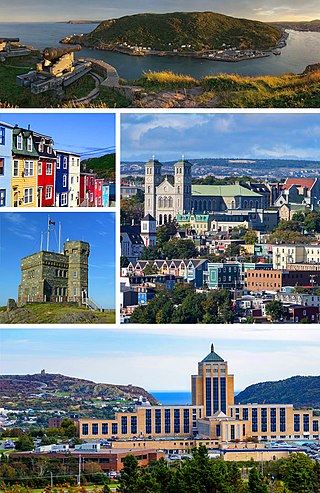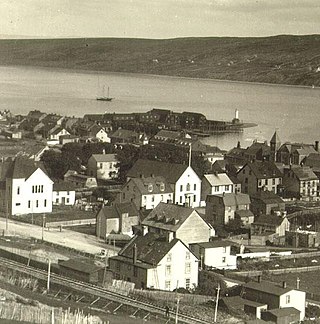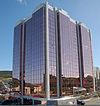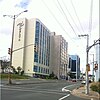
St. John's is the capital and largest city of the Canadian province of Newfoundland and Labrador. It is located on the eastern tip of the Avalon Peninsula on the island of Newfoundland. The city spans 446.04 km2 (172.22 sq mi) and is the easternmost city in North America.

The Newfoundland and Labrador House of Assembly is the unicameral deliberative assembly of the General Assembly of Newfoundland and Labrador of the province of Newfoundland and Labrador, Canada. It meets in the Confederation Building in St. John's. Bills passed by the assembly are given royal assent by the lieutenant governor of Newfoundland and Labrador, in the name of the King of Canada.

The Great Fire of 8 July 1892 in St. John's, Newfoundland and Labrador is remembered as the worst disaster ever to befall that city. Previous "Great Fires" had occurred in St. John's, during 1819 and 1846.

The Basilica-Cathedral of St. John the Baptist in St. John's, Newfoundland and Labrador is the metropolitan cathedral of the Roman Catholic Archdiocese of St. John's, Newfoundland and the mother church and symbol of Roman Catholicism in Newfoundland. The building sits within the St. John's Ecclesiastical District, a National Historic District of Canada.

The Cathedral of St. John the Baptist is an Anglican cathedral located in the city of St. John's, Newfoundland and Labrador, Canada. The church is considered to be the mother church for Anglicans in Newfoundland and Labrador.

Harbour Grace is a town in Conception Bay on the Avalon Peninsula in the province of Newfoundland and Labrador, Canada. With roots dating back to the 16th century, it is one of the oldest towns in North America.

The Bank of British North America Building built in the Italianate style was constructed in 1849 for the British Bank of North America, Newfoundland's first commercial bank. The building was built after the St. John's fire of 1846 by Halifax architect David Stirling.

Quidi Vidi is a neighbourhood in St. John's, Newfoundland and Labrador. Its pronunciations vary, even amongst longtime residents, but "Kiddy Vidi" is the most common. One theory behind the name is that it was named after a beloved cat named Vidi. The village is adjacent to Quidi Vidi Lake. Quidi Vidi's harbour is known as "The Gut". Located in Quidi Vidi is the Quidi Vidi Battery Provincial Historic Site. The village is home to several small businesses.

Anderson House is a wooden, two and one half storey hip roofed heritage-designated building located at 42 Powers Court, St. John's, Newfoundland and Labrador. It is a Vernacular Georgian style building and is reported to be one of the oldest structures in the city of St. John's.

Georgestown is a Neighbourhood Improvement Area in St. John's, Newfoundland and Labrador a short distance north from downtown of St. John's. This was established in the 1970s as part of an effort by Federal and local government to improve inner cities. Originally what was known as Georgestown village was much smaller and only "extended from Donnelly's Lane to what is now Belvedere Street". The neighbourhood improvement area includes, in addition to the original Georgestown, the former Monkstown and Tubridtown, along with adjoining land, including Circular Road, and Belvedere Street as well as some other parts of the former Belvedere Estate. It is bordered by Military Road, Monkstown Road, Empire Avenue, a small part of Carpasian Road, the east side of Bonaventure Avenue, and Holy Heart and Brother Rice Schools to the west. It was settled, around 1819, as the city's first suburb. The name is an evolution of "George (Winter)'s Town", as it was known in the 19th century.

The LSPU Hall is a large wooden structure in St. John's, Newfoundland and Labrador. Located on 3 Victoria Street, it is currently the home of the Resource Centre for the Arts (RCA). The name comes from a previous owner, the Longshoremen's Protective Union. The Hall is a registered heritage building.

O'Reilly House is a museum located in Placentia, Newfoundland and Labrador, Canada. It was built for Magistrate William O'Reilly who served as Magistrate of Placentia from 1897-1923. He was the son of Thomas O'Reilly who had been the magistrate of Placentia from 1877-97. In 1902, Magistrate O’Reilly employed the architect W.J. Ellis to build a Balustrade Queen Anne Victorian house that would serve as his family home.

Heart's Content Cable Station is a former cable landing station located in Heart's Content, Newfoundland and Labrador. It served as the western terminus of the first permanent trans-oceanic submarine telegraph cable, while a sister cable station on Valentia Island, Ireland, served as the eastern terminus. The original cable was first brought ashore in Heart's Content on July 27, 1866, and the station remained in use until it was closed in 1965. The station was designated a Provincial Historic Site in 1974 and is now a museum. On December 20, 2017, it was announced that the Heart's Content Cable Station would be one of eight new sites nominated by the Canadian Government for UNESCO World Heritage Site status.
The Green Family Forge is a two-storey, wooden, heritage-designated blacksmith shop located at the intersection of West Street at Dandy Lane in Trinity, Trinity Bay, Newfoundland and Labrador.

Greenspond Courthouse is a wooden two-storey, heritage-designated courthouse built in the Second Empire style in Greenspond, Newfoundland and Labrador. Designed by the architect William Henry Churchill, the courthouse sits atop a hill overlooking Greenspond Harbour and Bonavista Bay. It replaced an earlier courthouse in the community.

Mallard Cottage is a heritage-designated building located within Quidi Vidi Village in the City of St.John's, Newfoundland and Labrador. The cottage is a one-and-a-half-stories with a hipped roof and central chimney. The architecture is an example of early 19th century vernacular style patterned on Irish thatched-roofed cottages. Though the exact date of construction cannot be confirmed, based on evidence from construction techniques, architectural style, and oral history the date for its construction are placed between 1820 and 1840, making it one of the oldest residential structures in St. John's. Two other buildings in St.John's of the same style are Anderson House, built 1804–1805, and Martin McNamara House, exact construction date unknown. These three structures are the best preserved examples of late 18th and early 19th century architecture in St.John's.

St. John's Ecclesiastical District is a formally-recognized heritage precinct, located in the central part of St. John's, Newfoundland and Labrador. It is composed of separate nodes containing buildings and spaces associated with the Roman Catholic, Anglican, United Church of Canada, and Presbyterian denominations and is representative of the involvement of Christian institutions in the history and political life of St. John's and the province.































